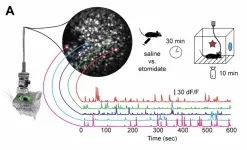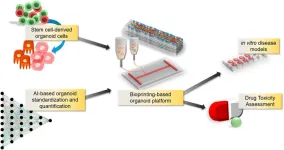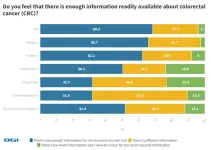(Press-News.org) OAK BROOK, Ill. – Researchers have found that digital breast tomosynthesis (DBT) has improved breast cancer screening performance in community practice and identifies more invasive cancers, compared to digital mammography. In addition, radiologists’ interpretive performance improved with DBT. The results of the study were published today in Radiology, a journal of the Radiological Society of North America (RSNA).
“Our study demonstrated that more radiologists in U.S. community practice are meeting recommended performance standards with digital breast tomosynthesis than they did with digital mammography,” said lead author Christoph I. Lee, M.D., professor of radiology at the University of Washington (UW) School of Medicine in Seattle, director of the Northwest Screening and Cancer Outcomes Research Enterprise at UW, and adjunct professor of health systems and population health at the UW School of Public Health. “This is good news for women and breast cancer screening, as digital breast tomosynthesis has quickly become the most popular breast cancer screening modality in the U.S.”
After gaining U.S. Food and Drug Administration (FDA) approval in 2011, DBT was rapidly adopted in the U.S. As of September 2022, 84% of all mammography screening facilities in the U.S. had DBT units.
Breast cancer mortality reduction from routine screening is contingent upon radiologists’ interpretive performance. Since the Mammography Quality Standards Act was enacted in 1992, screening facilities and interpreting radiologists have been required to meet minimum quality standards. Beginning in 2006, the Breast Cancer Surveillance Consortium (BCSC) has published screening performance benchmarks. The BCSC is a collaborative network of breast imaging registries conducting research to assess and improve the delivery and quality of breast cancer screening and related patient outcomes.
To establish performance benchmarks for DBT screening and evaluate performance trends over time in U.S. community practices, the research team collected DBT screening exams from five BCSC registries between 2011 and 2018.
Performance measures included abnormal interpretation rate, cancer detection rate, sensitivity, specificity and false-negative rate.
Compared to BCSC digital mammography screening exams from the same time period and previously published BCSC and National Mammography Database performance benchmarks, all performance measures were higher for DBT except sensitivity and false-negative rate, which were similar to concurrent and prior digital mammography performance measures.
“Radiologists appear to perform better with digital breast tomosynthesis and have higher accuracy on screening 3D mammograms than 2D mammograms across U.S. practices,” Dr. Lee noted. “As this becomes the mainstay screening modality, we hope to see improved screening outcomes for women.”
A total of 896,101 women undergoing 2,301,766 screening exams—458,175 DBT and 1,843,591 2D digital mammography—were included in the retrospective study. The abnormal interpretation rate was 8.3%, cancer detection rate was 5.8 per 1,000 exams, sensitivity was 87.4%, and specificity was 92.2%.
With DBT, 97.6%, 91.8%, 75.0%, and 74.0% of assessed radiologists achieved the recommended acceptable performance ranges for cancer detection rate, sensitivity, abnormal interpretation rate and specificity, respectively.
Dr. Lee notes that these benchmarks are also very important for the emerging field of artificial intelligence.
“Any new AI tools aimed at improving mammography accuracy will have to revise their own performance goals based on the improved radiologist performance with DBT,” he said.
###
“National Performance Benchmarks for Screening Digital Breast Tomosynthesis: Update from the Breast Cancer Surveillance Consortium.” Collaborating with Dr. Lee were Linn Abraham, M.S., Diana L. Miglioretti, Ph.D., Tracy Onega, Ph.D., Karla Kerlikowske, M.D., Janie M. Lee, M.D., Brian L. Sprague, Ph.D., Anna N. A. Tosteson, Sc.D., Garth Rauscher, Ph.D., Erin J. A. Bowles, M.P.H., Roberta M. diFlorio-Alexander, M.D., and Louise M. Henderson, Ph.D., for the Breast Cancer Surveillance Consortium.
In 2023, Radiology is celebrating its 100th anniversary with 12 centennial issues, highlighting Radiology’s legacy of publishing exceptional and practical science to improve patient care.
Radiology is edited by Linda Moy, M.D., New York University, New York, N.Y., and owned and published by the Radiological Society of North America, Inc. (https://pubs.rsna.org/journal/radiology)
RSNA is an association of radiologists, radiation oncologists, medical physicists and related scientists promoting excellence in patient care and health care delivery through education, research, and technologic innovation. The Society is based in Oak Brook, Illinois. (RSNA.org)
For patient-friendly information on breast imaging, visit RadiologyInfo.org.
END
A key receptor regulating memory formation has been localized to interneurons, according to a study with implications for drug development. Robert Pearce and colleagues probed the localization of γ-aminobutyric acid type A receptors that incorporate α5 subunits (α5-GABAARs). α5-GABAARs are concentrated within the hippocampus, a brain structure that is essential for the formation of episodic memories. The general anesthetic etomidate blocks learning by targeting α5-GABAARs, as do many drugs designed to enhance cognition, intended for use in people with Alzheimer’s disease, ...
In the process of organoid manufacturing, bioprinting technology can not only facilitate the creation and maintenance of complex biological 3D shapes and structures, but also allow for standardization and quality control during production. And the addition of artificial intelligence, which can validate the product potential in the manufacturing process, allows to provide a more standardized source of cells for the organoid in terms of viability, function, etc. In other words, bioprinting combined with artificial intelligence is expected to perform real-time ...
Colorectal cancer (CRC) is the most diagnosed cancer among males and third among females in Saudi Arabia, with up to two-thirds diagnosed at an advanced stage, according to the King Faisal Specialist Hospital & Research Centre. This report shows Saudi Arabia has a high percentage of respondents (62.7%) who never took CRC tests, far higher than global average of 54.1%. This shows the Kingdom's Early Cancer Detection Program still needs to build greater awareness among the public.
To uncover attitudes and the ...
Highlights
Excessive alcohol consumption causes short-term and long-term health problems
An enzyme called ADH1B accelerates the breakdown of alcohol in the body
Researchers genetically engineered a probiotic to express ADH1B in mice
Mice treated with the probiotic recovered from alcohol exposure faster than untreated mice, and had fewer resulting health problems
Washington, DC – Excessive alcohol consumption leads to painful hangovers and accompanying headaches, fatigue, and nausea. Drinking alcohol has also been linked to a raft of health problems in the human body, including heart disease, cirrhosis, and immune deficiency. One way to avoid those consequences ...
In the United States, federal laws were created to effectively decriminalize prostitution in minors under the age of 18. However, state and local justice systems continue to arrest and incarcerate minors for prostitution, despite widespread agreement that youth involved in commercial sexual exploitation are victims, not offenders.
Most youth tend to fall victim to child prostitution and sex trafficking between the ages of 12 and 14. Victims of child prostitution have especially high rates of prior physical, sexual and emotional abuse as well as neglect.
Calli M. Cain, Ph.D., an assistant professor at Florida Atlantic University’s College of Social Work and Criminal ...
Complimentary press passes are now available for NUTRITON 2023, the annual flagship meeting of the American Society for Nutrition. Join us July 22-25 in Boston to hear about the latest developments in nutrition research, practice, and policy.
After three years of virtual meetings, NUTRITION 2023 will bring the nutrition community back together to share cutting-edge research on nutrition and food science, diet and disease, clinical applications, global health, and more. As one of the world’s largest nutrition ...
Scientists at The Hospital for Sick Children (SickKids) and the University of Toronto (U of T) have combined forces to develop a new approach to potentially treat tumour cells, called mechanical nanosurgery, even for aggressive, chemoresistant cancers.
Glioblastoma (GBM) is the most common and aggressive primary brain cancer. Despite various treatment options that exist, including surgery, radiotherapy, and chemotherapy, the median survival time for patients is only around 15 months.
The current global standard-of-care treatment for GBM patients includes chemotherapy using a drug called temozolomide (TMZ), which extends a person’s life expectancy by approximately two months compared ...
Ithaca, NY—Deteriorating habitat conditions caused by climate change are wreaking havoc with the timing of bird migration. A new study demonstrates that birds can partially compensate for these changes by delaying the start of spring migration and completing the journey faster. But the strategy comes with a cost—a decline in overall survival. The findings by researchers from Cornell University, the University of Maryland, and Georgetown University are published in the journal Ecology.
"We found that our study species, the American Redstart, can migrate up to 43% faster to reach its ...
The Korea Institute of Civil Engineering and Building Technology (KICT, President Kim, Byung-suk) has been participating as Korea’s representative organization in the Energy in Buildings and Communities (EBC) programme, an Technical Cooperation Programme under the International Energy Agency (IEA), since 2005.
The International Energy Agency Energy in Buildings and Communities Programme (IEA EBC) is an international research organization with 25 member countries including the United States, Japan, Germany, France, and, more recently, Brazil and Turkey. Established in 1977 in response to the global energy crisis, EBC aims to conduct research on conserving energy and ...
Viruses are usually associated with illness. But our bodies are full of both bacteria and viruses that constantly proliferate and interact with each other in our gastrointestinal tract. While we have known for decades that gut bacteria in young children are vital to protect them from chronic diseases later on in life, our knowledge about the many viruses found there is minimal.
A few years back, this gave University of Copenhagen professor Dennis Sandris Nielsen the idea to delve more deeply into this ...







